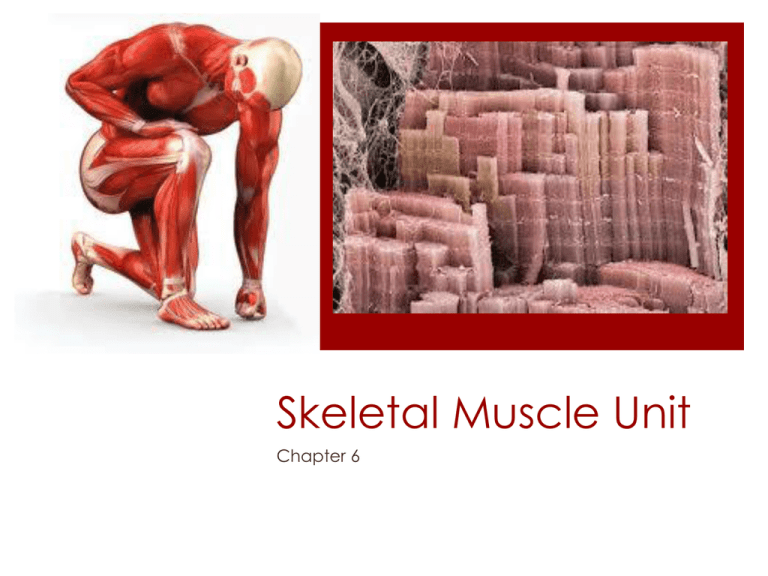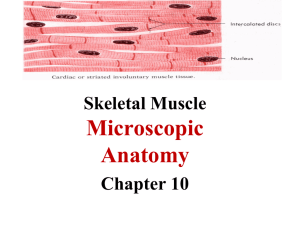Skeletal Muscle Unit Chapter 6
advertisement

Skeletal Muscle Unit Chapter 6 Functions of skeletal muscles Produce skeletal movement Maintain posture and body position Support soft tissues Guard entrances and exits Maintain body temperature Store nutrient reserves Organization of muscle Epimysium: an exterior collagen layer that separates the muscle from surrounding tissues. Perimysium: surrounds bundles of muscles fibers called fascicles. Perimysium holds the blood vessels and nerves that supply the fascicles. Endomysium: surrounds individual muscle cells (the muscle fibers), and contains the capillaries and nerve fibers that directly contact the muscle cells. Endomysium also contains stem cell that repair damaged muscles. Tendon and aponeurosis At each end of the muscle collagen fibers from the epimysium, perimysium, and endomysium come together. These fibers attach the muscle to the bone to allow for movement Myoblasts Myo: muscle Blast: Build Muscle Fiber (Cell) Structure Sarcolemma: The cell membrane of a muscle cell, which surrounds the sarcoplasm or cytoplasm of the muscle fiber. Transverse tubules: transmit action potentials Myofibrils: Within each muscle fiber are hundreds of lengthwise subdivisions called myofibrils. Myofilaments: two types of myofibrils Sarcomere The 2 types of myofilaments are: thin filaments: made of the protein actin, and thick filaments: made of the protein myosin. Sarcoplasmic Reticulum: Surrounding each myofibril is a membranous structure It is involved in transmitting the action potential to the myofibril. Ion pumps concentrate calcium ions (Ca++) that are released into the contractile units of the muscle (sarcomeres) at the beginning of a muscle contraction. A Band, I Band, Z Line Sarcomeres: the contractile units of muscle Structural units of myofibrils Skeletal muscles appear striped or striated because of the arrangement of alternating dark, thick filaments and light, thin filaments One sarcomere is measured from one Z line to another. A Band I band M line: The center of the A Z lines: The centers of band is the midline or M line the I bands are Z lines Zone of overlap: Where thick Titin: Strands of protein reach from the ends filaments and thin filaments of the thick filaments overlap which is the densest, to the Z line and darkest area stabilize the filaments Thin Filament Thin filaments contain 4 proteins: F actin (2 twisted rows of globular G actin. Active sites on G actin strands bind to myosin.) nebulin (holds F actin strands together) tropomyosin (a double strand, prevents actin-myosin interaction) troponin (a globular protein, binds tropomyosin to G actin, controlled by Ca++) Thin Filament When a Ca++ ion binds to the receptor on a troponin molecule, the troponintropomyosin complex changes, exposing the active site of the F actin and initiating contraction. Thick Filament Thick Filaments contain twisted myosin subunits. The tail binds to other myosin molecules. The free head, made of 2 globular protein subunits, reaches out to the nearest thin filament. Thick Filament During a contraction, myosin heads interact with actin filaments to form cross-bridges. The myosin head pivots, producing motion. Thick filaments contain strands that recoil after stretching. Sliding Filament Theory In skeletal muscle contraction, the thin filaments of the sarcomere slide toward the M line, in between the thick filaments. This is called the sliding filament theory. The width of the A zone stays the same, but the Z lines move closer together. Motor Unit Muscle fiber contraction is initiated by neural stimulation of a sarcolemma. Calcium ions trigger the interaction of thick and thin filaments, consuming ATP and producing a pulling force called tension. Neural stimulation occurs at the neuromuscular junction. The electrical signal or action potential travels along the nerve axon and ends at a synaptic terminal which releases a chemical neurotransmitter called acetylcholine (ACh). Action Potential ACh travels across a short gap and binds to membrane receptors on the sarcolemma, causing sodium ions to rush into the sarcoplasm. The increase in sodium ions generates an action potential in the sarcolemma which travels along the T tubules. When the action potential reaches a triad, calcium ions are released, triggering contraction. This step requires the myosin heads to have previously broken down ATP and stored the potential energy in the “cocked” position. ATP and CP Reserves At rest muscles produce more ATP than needed, it is turned into creatine (a high energy compound) Energy in creatine is used to assemble ADP and Pi (phosphate) to recharge it to make ATP. Contraction Cycle The Contraction Cycle has 5 steps: 1. (Ca++ introduction stimulated by neurons) Exposure of active sites 2. Formation of crossbridges 3. Pivoting of myosin heads (uses ATP) 4. Detachment of cross-bridges 5. Reactivation of myosin Reformation of ATP by reassembling ADP with Creatine Phosphate Aerobic vs Anaerobic Aerobic metabolism uses O2 and provides 95% of ATP for a resting cell the primary energy source of resting muscles 32 ATP molecules produced per glucose molecule Aerobic vs Anaerobic Anaerobic glycolysis: does not use O2, provides 5% of the ATP for a resting cell the breakdown of glucose from glycogen primary energy source for peak muscular activity 2 ATP molecules produced per molecule of glucose skeletal muscles store glycogen Glycolysis (breaks down Bigglucose Energyinto Events of Respiration two molecules of pyruvate) The citric acid cycle (completes the breakdown of glucose) Oxidative phosphorylation (accounts for most of the ATP synthesis) Lactic Acid and Fatigue At peak levels of exertion, muscles can’t get enough oxygen to support mitochondrial activity. The muscle then relies on glycolysis for ATP. Glycolysis produces pyruvic acid The pyruvic acid produced by glycolysis, which would normally be used up by the mitochondria, starts to build up and is converted to lactic acid. Lactic Acid and Fatigue Fatigue is when the muscle uses reserves and can no longer perform the required activity 1. depletion of metabolic reserves 2. damage to the sarcolemma/sarcoplasmic reticulum 3. low pH (lactic acid) 4. muscle exhaustion and pain Recovery Period After high levels of exertion, it can take hours or days for muscles to return to their normal condition. During the recovery period, oxygen is once again available and mitochondrial activity resumes. To process excess lactic acid and normalize metabolic activities after exercise, the body uses more oxygen than usual. This elevated need for oxygen, called the oxygen debt, is responsible for heavy breathing after exercise. Cori cycle: Lactic acid is carried by the blood stream to the liver, where it is converted back into pyruvic acid, and glucose is released to recharge the muscles’ glycogen reserves. Skeletal muscles at rest metabolize fatty acids and store glycogen. Players in Contraction Agonist (Batman): Prime mover-does the main portion of the work Antagonist (Joker): Resists the prime mover-pulls against Synergist (Robin): Assist the agonisthelper Types of Contractions There are 2 basic patterns of muscle tension: In isotonic contraction, the muscle changes length, resulting in motion. If muscle tension exceeds the resistance, the skeletal muscle shortens (concentric contraction). If muscle tension is less than the resistance, the muscle unshortens (eccentric contraction). In isometric contraction, the muscle is prevented from changing length, even though tension is developed. Heat Production and Loss: The more active muscles are, the more heat they produce. During strenuous exercise, up to 70 percent of the energy produced can be lost as heat, raising body temperature. Levers Origin, Action, Innervation Building Muscle Hypertrophy: Extensive training can cause muscles to grow by increasing the diameter of the muscle fibers, which increases the number of myofibrils, mitochondria and glycogen reserves. Atrophy: Lack of muscle activity causes reduction in muscle size, tone and power. What you don’t use, you loose. Muscle tone is an indication of the background level of activity. When inactive for days or weeks, muscles become untoned. The muscle fibers break down and become smaller and weaker. If inactive for long periods of time, muscle fibers may be replaced by fibrous tissue.






